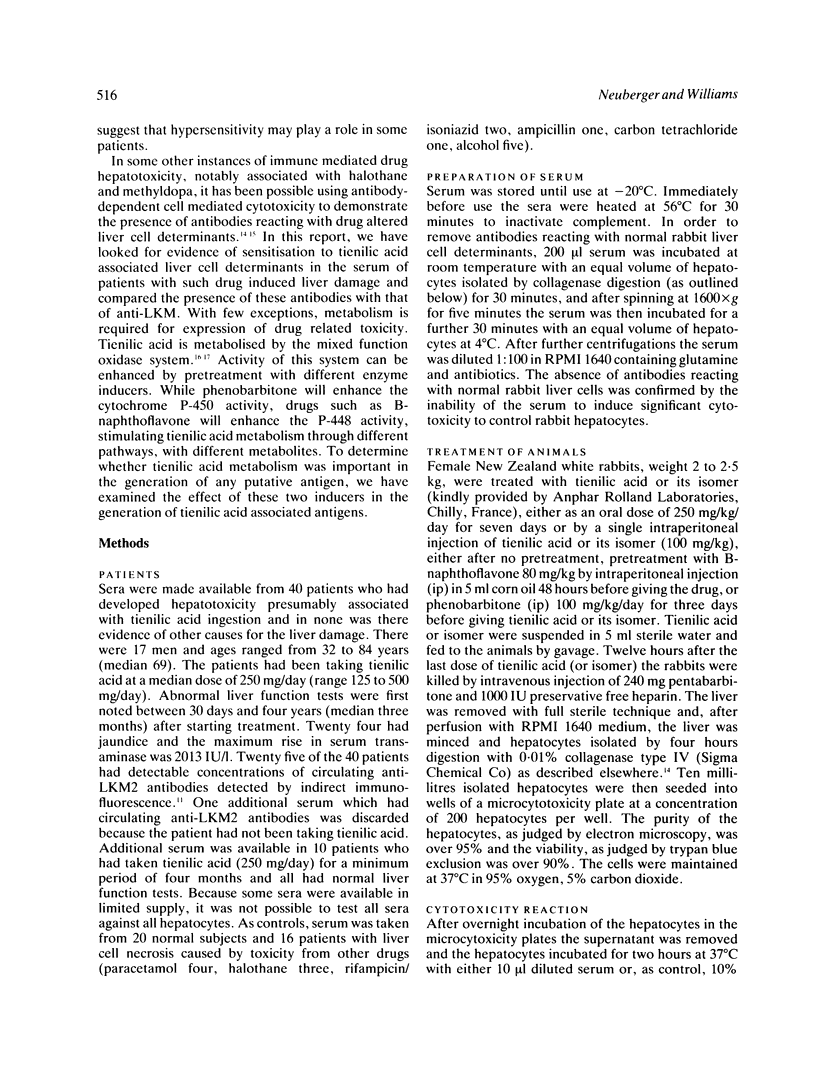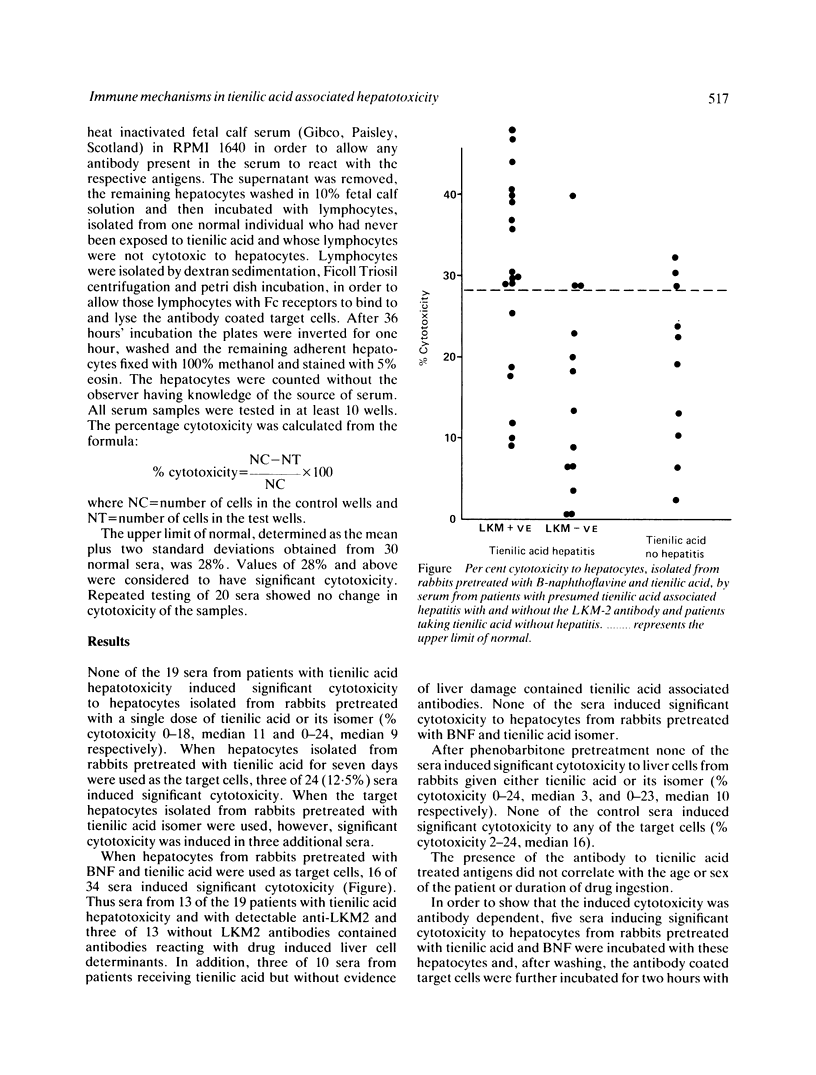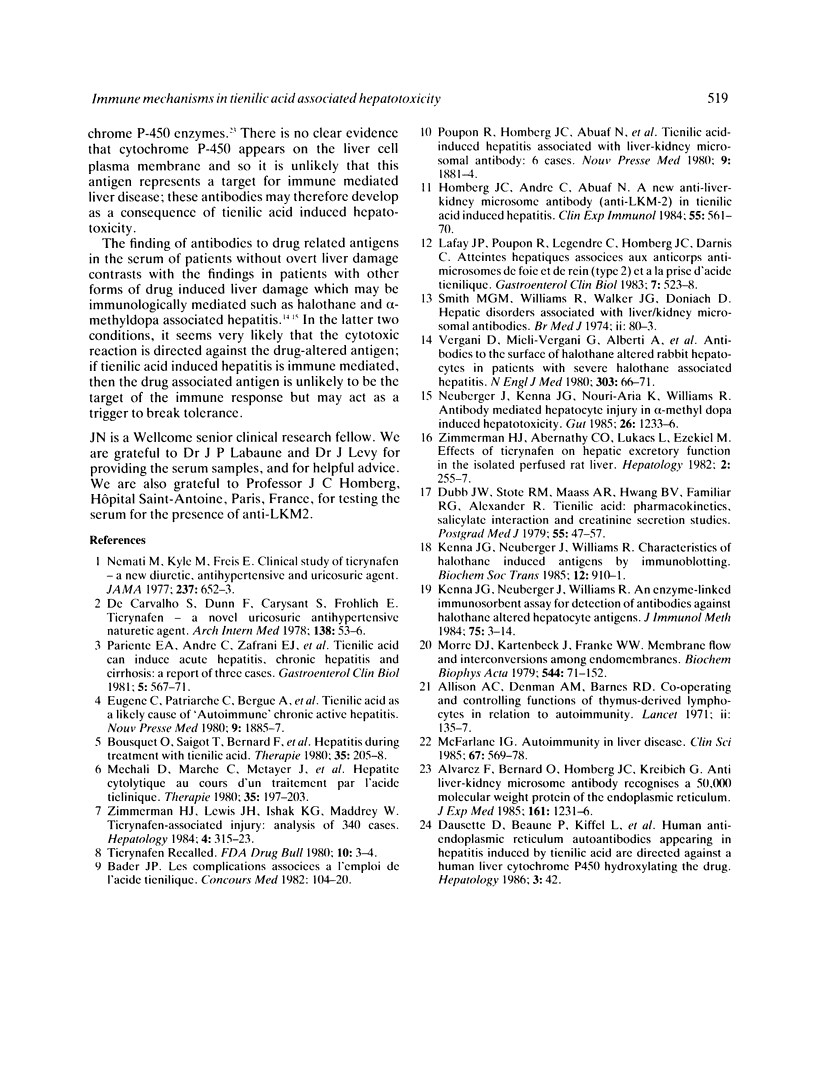Abstract
In order to investigate the mechanisms underlying the hepatotoxicity associated with tienilic acid (Ticrynafen) ingestion we have looked for evidence of sensitisation to drug altered liver cell determinants using an indirect antibody dependent, cell mediated cytotoxicity assay (ADCC). As targets, hepatocytes were isolated from rabbits pretreated with either tienilic acid or its isomer with or without previous enzyme induction with either phenobarbitone or B-naphthoflavone (BNF). Sera from 16 of 36 patients with presumed tienilic acid hepatotoxicity induced significant cytotoxicity to hepatocytes isolated from rabbits pretreated with BNF and subsequently tienilic acid. Three of 10 sera from patients receiving tienilic acid but without overt liver damage also induced significant cytotoxicity to these hepatocytes, however, although none of 20 normal controls or of 16 patients with other liver diseases did so. Non-organ specific autoantibodies, classified as anti-LKM2, were also detectable. These were present in association with tienilic acid associated antibodies: of the 36 patients with presumed tienilic acid hepatotoxicity, 38% had both antibodies, 18% had only anti-LKM2 antibodies and 9% only tienilic acid associated antibodies. These results suggest that this drug reaction is associated with sensitisation to drug altered liver cell antigens and autoantigens. If ticrynafen associated hepatotoxicity is immune mediated, then one possible mechanism is that the drug induced antigens break tolerance, leading to an immune attack on normal liver cell components.
Full text
PDF




Selected References
These references are in PubMed. This may not be the complete list of references from this article.
- Allison A. C., Denman A. M., Barnes R. D. Cooperating and controlling functions of thymus-derived lymphocytes in relation to autoimmunity. Lancet. 1971 Jul 17;2(7716):135–140. doi: 10.1016/s0140-6736(71)92306-3. [DOI] [PubMed] [Google Scholar]
- Alvarez F., Bernard O., Homberg J. C., Kreibich G. Anti-liver-kidney microsome antibody recognizes a 50,000 molecular weight protein of the endoplasmic reticulum. J Exp Med. 1985 May 1;161(5):1231–1236. doi: 10.1084/jem.161.5.1231. [DOI] [PMC free article] [PubMed] [Google Scholar]
- Bousquet O., Saigot T., Bernard P., Gerbal J. L., Sarrazin A. Hépatite secondaire à la prise d'acide tiénilique. Therapie. 1980 Mar-Apr;35(2):205–208. [PubMed] [Google Scholar]
- Dubb J. W., Stote R. M., Maass A. R., Hwang B. V., Familiar R. G., Alexander F. Tienilic acid: pharmacokinetics, salicylate interaction and creatinine secretion studies. Postgrad Med J. 1979;55 (Suppl 3):47–57. [PubMed] [Google Scholar]
- Eugène C., Patriarche C., Bergue A., Quevauvilliers J. Hépatite active "auto-immune": responsabilité vraisemblable de l'acide tiénilique. Nouv Presse Med. 1980 Jun 21;9(27):1885–1887. [PubMed] [Google Scholar]
- Homberg J. C., Andre C., Abuaf N. A new anti-liver-kidney microsome antibody (anti-LKM2) in tienilic acid-induced hepatitis. Clin Exp Immunol. 1984 Mar;55(3):561–570. [PMC free article] [PubMed] [Google Scholar]
- Kenna J. G., Neuberger J., Williams R. An enzyme-linked immunosorbent assay for detection of antibodies against halothane-altered hepatocyte antigens. J Immunol Methods. 1984 Dec 14;75(1):3–14. doi: 10.1016/0022-1759(84)90219-9. [DOI] [PubMed] [Google Scholar]
- Lafay J. P., Poupon R., Legendre C., Homberg J. C., Darnis F. Atteintes hépatiques associées aux anticorps antimicrosomes de foie et de rein (type 2) et a la prise d'acide tiénilique. Une étude de 37 cas. Gastroenterol Clin Biol. 1983 May;7(5):523–528. [PubMed] [Google Scholar]
- McFarlane I. G. Autoimmunity in liver disease. Clin Sci (Lond) 1984 Dec;67(6):569–578. doi: 10.1042/cs0670569. [DOI] [PubMed] [Google Scholar]
- Mechali D., Marche C., Metayer J., Saimot G., Matheron S., Rozenbaum W., Coulaud J. P. Hépatite cytolytique au cours d'un traitement par l'acide tiénilique. Therapie. 1980 Mar-Apr;35(2):197–203. [PubMed] [Google Scholar]
- Nemati M., Kyle M. C., Freis E. D. Clinical study of ticrynafen. A new diuretic, antihypertensive, and uricosuric agent. JAMA. 1977 Feb 14;237(7):652–656. [PubMed] [Google Scholar]
- Neuberger J., Kenna J. G., Nouri Aria K., Williams R. Antibody mediated hepatocyte injury in methyl dopa induced hepatotoxicity. Gut. 1985 Nov;26(11):1233–1239. doi: 10.1136/gut.26.11.1233. [DOI] [PMC free article] [PubMed] [Google Scholar]
- Pariente E. A., André C., Zafrani E. S., Métreau J. M., Dhumeaux D., Berthelot P. Hépatite aiguë, hépatite chronique et cirrhose a l'acide tiénilique. Gastroenterol Clin Biol. 1981 May;5(5):567–571. [PubMed] [Google Scholar]
- Poupon R., Homberg J. C., Abuaf N., Petit J., Bodin F., Darnis F. Atteintes hépatiques dues à l'acide tiénilique. Six observations avec présence d'anticorps antireticulum endoplasmique. Nouv Presse Med. 1980 Jun 21;9(27):1881–1884. [PubMed] [Google Scholar]
- Smith M. G., Williams R., Walker G., Rizzetto M., Doniach D. Hepatic disorders associated with liver-kidney microsomal antibodies. Br Med J. 1974 Apr 13;2(5910):80–84. doi: 10.1136/bmj.2.5910.80. [DOI] [PMC free article] [PubMed] [Google Scholar]
- Vergani D., Mieli-Vergani G., Alberti A., Neuberger J., Eddleston A. L., Davis M., Williams R. Antibodies to the surface of halothane-altered rabbit hepatocytes in patients with severe halothane-associated hepatitis. N Engl J Med. 1980 Jul 10;303(2):66–71. doi: 10.1056/NEJM198007103030202. [DOI] [PubMed] [Google Scholar]
- Zimmerman H. J., Abernathy C. O., Lukacs L., Ezekiel M. Effects of ticrynafen on hepatic excretory function in the isolated perfused rat liver. Hepatology. 1982 Mar-Apr;2(2):255–257. doi: 10.1002/hep.1840020212. [DOI] [PubMed] [Google Scholar]
- de Carvalho J. G., Dunn F. G., Chrysant S. G., Frohlich E. D. Ticrynafen: a novel uricosuric antihypertensive natriuretic agent. Arch Intern Med. 1978 Jan;138(1):53–57. doi: 10.1001/archinte.138.1.53. [DOI] [PubMed] [Google Scholar]


